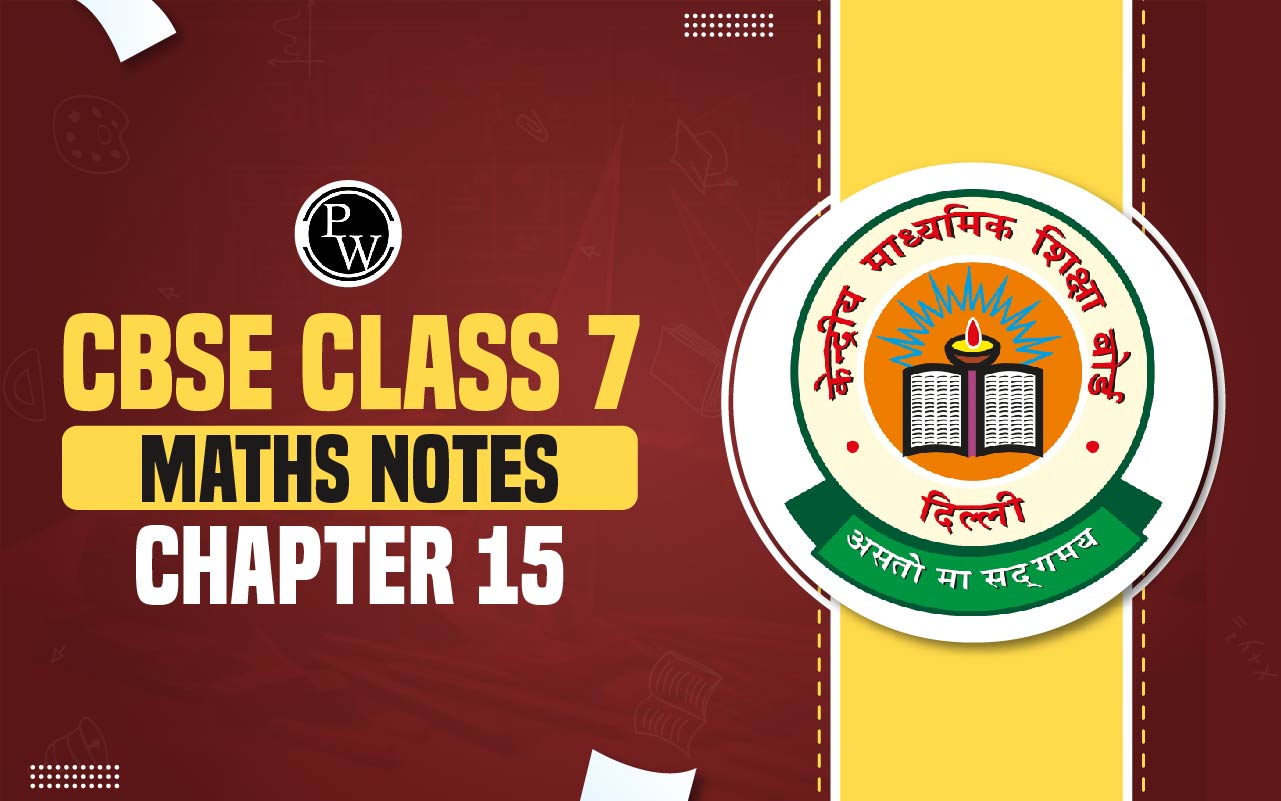

CBSE Class 7 Maths Notes Chapter 15: These free PDF notes encourage young brains to explore the fascinating world of three-dimensional objects by acting as treasure maps. This chapter reveals the mysteries of seeing and comprehending solid shapes, from cubes to cylinders.
The notes are helpful and make difficult ideas easier to understand and open doors to a deeper understanding of spatial geometry. Explore "Visualising Solid Shapes," a place where learning turns into a fascinating journey and comprehending the geometry of our three-dimensional environment is as easy as opening a PDF.CBSE Class 7 Maths Notes Chapter 15 PDF
In Class 7 Maths, "Visualising Solid Shapes," the beauties of three dimensions are revealed. This chapter encourages students to investigate and comprehend the mysteries of solid shapes, ranging from cubes to cones. As students set out to imagine and distinguish these shapes in common things, concepts like edges, vertices, and faces come to life. Here we have provided CBSE Class 7 Maths Notes Chapter 15 Visualising Solid Shapes pdf -CBSE Class 7 Maths Notes Chapter 15 PDF
CBSE Class 7 Maths Notes Chapter 15 Visualising Solid Shapes
Dimensions
- A dimension is a length along a direction that can be measured.
- Length, breadth, or height (or depth) are the three dimensions.
- A point has no dimensions.
- There are one-dimensional, two-dimensional, and three-dimensional figures depending on how many dimensions they have.
1D and 2D figures
One-dimensional figures have only one direction and no region around them. A line segment or a beam are two examples. Every two-dimensional figure has a corresponding area. They possess both breadth and length. Typically, they are flat shapes like squares, rectangles, and circles.
Solid Shapes
- Solid shapes have length, breadth or width, and depth or height.
- They are called 3D or three-dimensional shapes.
- Example: Cuboids, Cylinders, Spheres and Pyramids.

Perspectives of a Solid Shape
Visualising solid shapes
There are various ways to perceive solid shapes. One way to create new solid shapes is to arrange existing solid shapes next to one another. For instance: (i) Circles are stacked vertically to make a cylinder. (ii) Cubes can be created by arranging cubes next to one another.
Visualising solid objects by viewing the smallest unit
When a solid is broken down to its smallest unit, it can be visually represented. For instance, 27 little cubes with dimensions of 1 cm by 1 cm by 1 cm can be assembled to form a cube with dimensions of 3 cm by 3 cm by 3 cm.
Viewing sections of a solid by slicing or cutting
We can see the cross-section of a solid when it is sliced or cut. An illustration of this would be a vertically cut loaf of bread, whose crosssection is nearly square. However, the cross-section becomes a rectangle when it is sliced or chopped horizontally. It is possible to slice other solid objects in a similar way to determine their 2D cross-sectional shapes. For instance, a vertically cut cucumber forms a circle.
Viewing sections of a solid by using shadows
- Shadows can be used to view 3D objects as 2D shapes.
-
Example: The shadows of a cylinder are shown below.

Different views of a Solid
It is possible to envisage a solid by examining it from the following perspectives: (i) front, (ii) top, and (iii) side. Example: The figure's many views are displayed below.| CBSE Syllabus Class 7 | |
| CBSE Class 7 English Syllabus | CBSE Class 7 Math Syllabus |
| CBSE Class 7 Social Science Syllabus | CBSE Class 7 Science Syllabus |
Quantities Associated with a Solid
Faces, edges and vertices
The vertices of a solid form are its corners. An edge is the section of a line that connects two vertices, or it is formed when two planes of a solid come together. A solid shape's surfaces are referred to as its face. The table below shows the number of faces, edges and vertices some solid shapes have.
The table below shows the number of faces, edges and vertices some solid shapes have.

Nets of Solid Shapes
Building 3-D objects
A net is a flattened out skeletal outline or a blueprint of a solid which can be folded along the edges to create a solid. The same solid can have multiple nets. Example: A net for a cube box.
Related Links -
Representing 3D Shapes on Paper
Drawing solids on a flat surface
- Paper is a 2D flat surface that can be used to represent solid shapes.
- To create the illusion of three dimensions, slanted sketches are created. This is referred to as a 2D solid's representation in 3D.
Obliques sketches
- Oblique sketches do not have the exact length of a solid shape but appear exactly like the solid shape.
-
Example: Drawing an oblique sketch of a cube:
Step 1 : Draw the front and the opposite faces.
Step 2: Join the corresponding corners. (Figure 1)
Step 3: Redraw using dotted lines for hidden edges. (Figure 2)

Isometric sketches
- Isometric sketches have measurements equal to that of the solid.
- They are usually drawn on an isometric dotted paper.
- Example: Drawing an isometric sketch of a cuboid of dimensions 4 × 3 × 3:
Step 1: Draw a rectangle to show the front face of the cuboid.

Step 2: Draw four parallel line segments of length three starting from the four corners of the rectangle.

Step 3: Connect the corresponding corners using appropriate line segments.

Step 4: The figure thus obtained is the isometric sketch of the cuboid.

CBSE Class 7 Maths Notes Chapter 15 FAQs
How can I get full marks in CBSE 7th maths?
Is 7th maths easy?
What are the notes about solid shapes?












